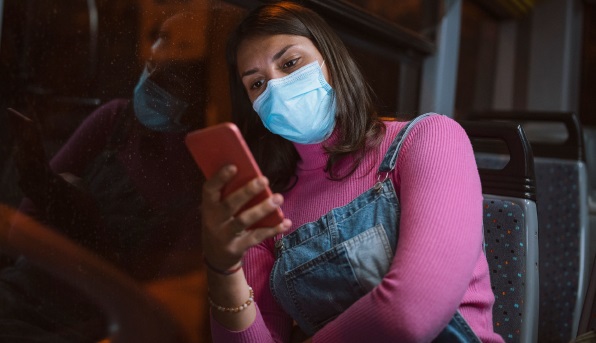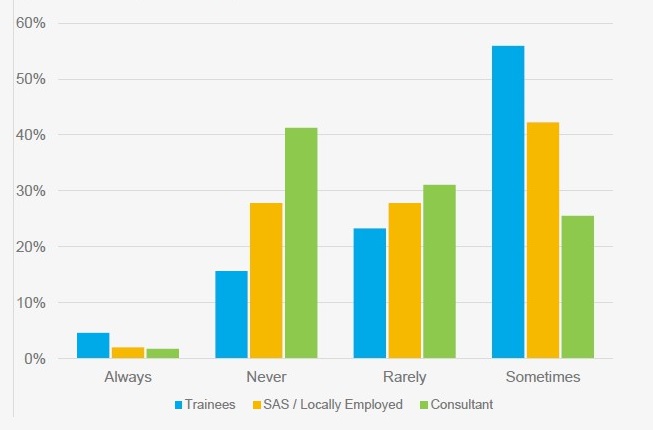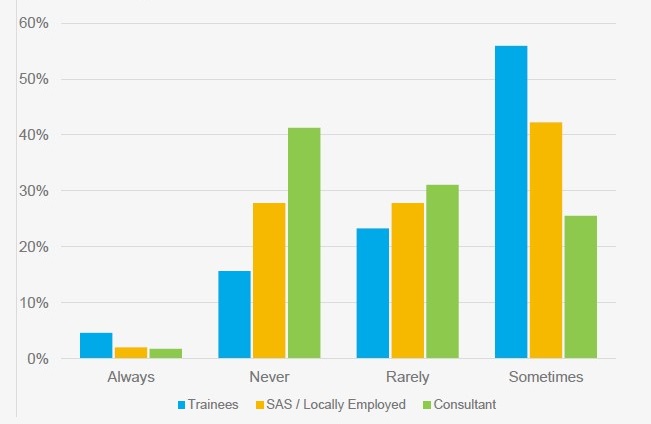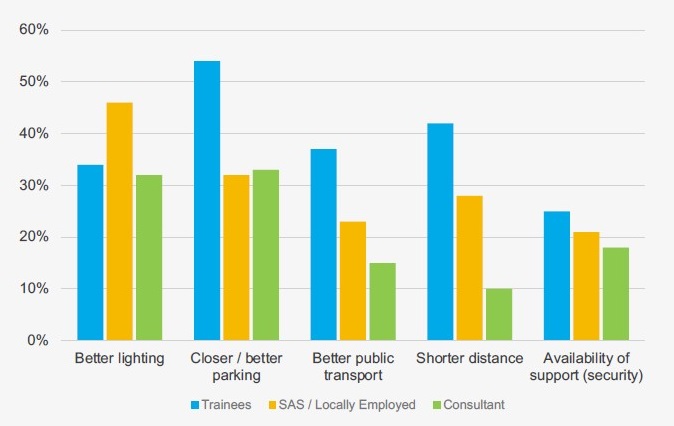Safer travel to work – a nationwide survey of experiences

During the COVID-19 pandemic,
many hospitals introduced initiatives
to improve the wellbeing of staff who
were still travelling to work when many
of the public were working from home
or were furloughed. Many organisations
suspended their parking charges and
some road and rail travel became free or
subsidised for keyworkers. While other
programmes associated with lockdown
have become permanent, many changes
relating to travel to and from work have
been rolled back. After controversy over
the reintroduction of a parking permit
scheme at one UK hospital, the Board of
the Association of Anaesthetists began to
discuss how anaesthetists travel to work
and what we could do to support our
membership.
Many of us have experienced issues associated with long
commutes, difficult journeys, unconventional parking
arrangements, or having to park in residential areas. These
issues include minor inconveniences such as unhelpful bus
timetables and inadequate parking at remote hospital sites,
but also more important factors involving safety including
travelling while fatigued or late at night, and the risk of
crime. These all contribute to making our days more difficult,
potentially before they even start.
Though these anecdotes sounded familiar, we had no
hard evidence that this was an issue. We decided to
conduct a nationwide survey of all Association members
between December 2022 - February 2023. We asked about
commuting including duration, travel method, perceptions
of safety, and whether these would influence employment
choices. We explored whether our members had
experienced crime related to commuting journeys. Free text
options were included.
We had over 960 replies, representing over 10% of our
membership. The majority of responses came from doctors
working clinically, with a small number from medical students,
anaesthesia associates and retired doctors.
Overall, 38% respondents took between 30-60 min to get
to work (Figure 1). Notably, 22% of those who had to travel
more than an hour were trainees, compared with 12% of SAS/
locally-employed doctors and 6% of consultants. When asked
how often travel is undertaken when it is dark, 98% answered
‘sometimes’ or ‘always’, perhaps reflecting emergency work as
well as the need to be in before sunrise or travel home after
sunset during winter months.
Figure 1. How long does it take you to commute?

Figure 2. Over the last six months, have you ever felt unsafe travelling to/from work?

Figure 3. What would make you feel safer travelling to/from work?

Perhaps unsurprisingly, groups of doctors
more likely to be undertaking resident shift-working
reported longer commutes and
were more likely to travel in the dark. Trainees
are disproportionately affected compared
with SAS, locally employed doctors and
consultants. The latter groups are often in
substantive posts in one hospital and therefore
likely to live nearer their place of work.
When asked about how safe people feel
travelling to work, 34% of respondents
‘sometimes’ felt unsafe travelling to work; the
majority of these were trainees (56%), followed
by SAS/ locally employed doctors (42%)
and consultants (26%). Alarmingly a small
proportion ‘always’ felt unsafe (Figure 2).
We asked what would make anaesthetists
feel safer travelling to work, and the answers
were as one might expect: better lighting in
car parks; shorter travelling distances; better
public transport; and greater availability of
on-site security support (Figure 3). Trainees
were more likely to report that they would feel
safer if they had access to better and closer
parking facilities than other groups, reflecting
that permanent staff have better access to
regulated car parks in some organisations.
From an environmental viewpoint, 17% of
respondents cycle to work at least some of
the time, the majority of these as their main
method of commuting. It was encouraging
that 80% of these 154 doctors report being
able to park their bikes safely. However, there
were also multiple references to bicycle theft
in the free text answers. As we all look towards
greener ways to travel, secure storage and
safe cycle routes to and from hospitals should
be a key focus of healthcare infrastructure.
Overall, 70% of respondents drive to work at
least some of the time, most using a car as
their main method of commuting. There were
some free text comments related to difficulty
getting a parking permit, the cost of parking,
and problems finding a parking space; 46%
of respondents could park at work but had to
pay, and 20% could park for free.
Only 8% of respondents report using public
transport some of the time, with 7% overall
using public transport as their main method
of commuting. The majority of those using
public transport report that the bus stop is
either within the hospital premises, or close to
the hospital. The regularity of public transport
to hospital sites varied significantly; overall
21% of respondents said that better public
transport would make them feel safer on their
journey.
Regarding safety, 81 (8%) respondents reported being
a victim of crime on their work journey. This ranged
from verbal abuse through to assault and attempted or
actual theft of possessions or vehicles. Fatigue was still
a common theme in the free text comments, including
reports of ‘microsleeps’ at the wheel, falling asleep at traffic
lights resulting in collision, and not being able to access
hospital rest facilities, with some feeling pressured to drive
home. The #FightFatigue campaign has been part of the
Association of Anaesthetists advocacy work since 2017,
and has resulted in improvements in hospital facilities for
those working unsociable hours [1]. There is clearly still
work to be done, and data from this survey should help
add weight to that campaign.
An impact on psychological wellbeing from commuting
was reported by 17%, and 25% said that it had been a
factor in deciding where to live, with many stating it directly
influenced choice of employment. Decisions about where
to take a permanent job are multifactorial, but employers
may find recruitment and retention easier if they address
some of the issues reported by our members.
We realise that this survey is just the beginning of what may
be a long fight to improve hospital facilities to a standard
where workers are enabled rather than feeling hindered in
doing their jobs. There are multiple forces at play here, not
least from those that own and run hospital estates, councils,
government policy and transport companies.
Our next step in this campaign is to write to the chief
executives of each UK Trust and Board with the results
of this survey, along with steps they could take to help
improve safe travel in their area. We also intend to present
these data in greater depth in some of our forthcoming
educational events in order to raise awareness. This article
is also one step in getting the word out, so thank you for
reading.
If you would like to know more about the campaign
or learn how to get involved, please contact
[email protected].
Naomi Freeman
Immediate Past Chair, Association of Anaesthetists Trainee
Committee
Consultant Anaesthetist, Royal Infirmary of Edinburgh
Robert James Fleming
Honorary Membership Secretary, Association of
Anaesthetists
Specialist Anaesthetist, Sherwood Forest Hospitals NHS
Foundation Trust
Twitter: @DrNFreeman, @RobJimFleming
References
- Association of Anaesthetists. Fatigue, 2023.
https://anaesthetists.org/Fatigue (accessed
29/8/2023).